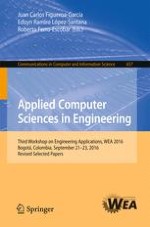2016 | Book
Applied Computer Sciences in Engineering
Third Workshop on Engineering Applications, WEA 2016, Bogotá, Colombia, September 21-23, 2016, Revised Selected Papers
Editors: Juan Carlos Figueroa-García, Eduyn Ramiro López-Santana, Roberto Ferro-Escobar
Publisher: Springer International Publishing
Book Series : Communications in Computer and Information Science
